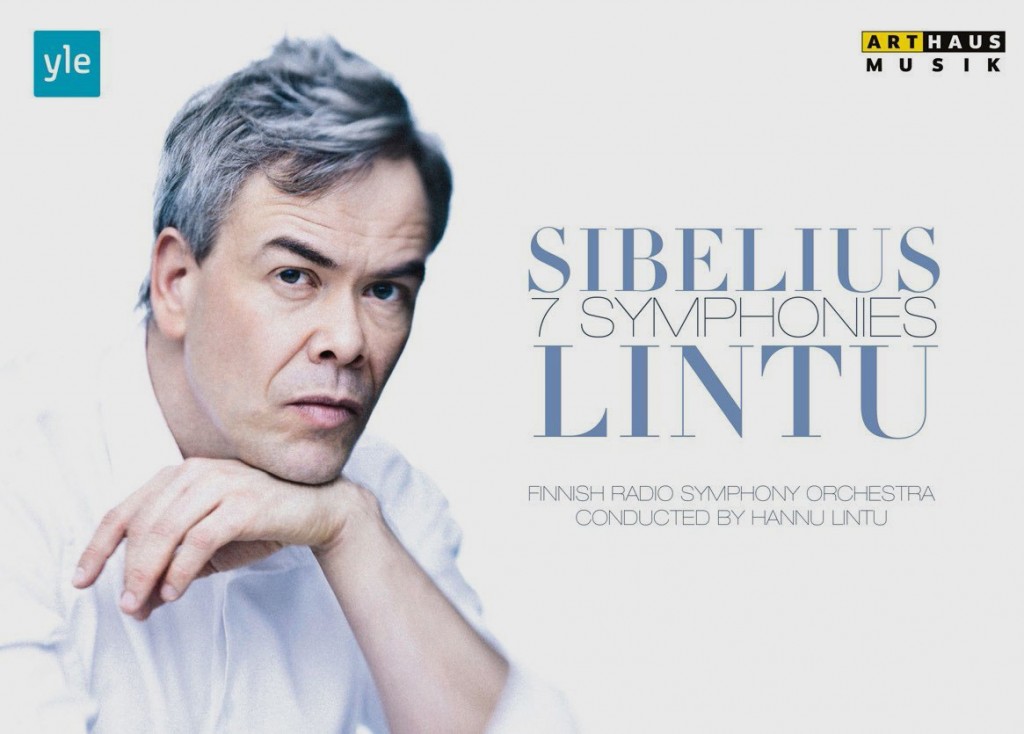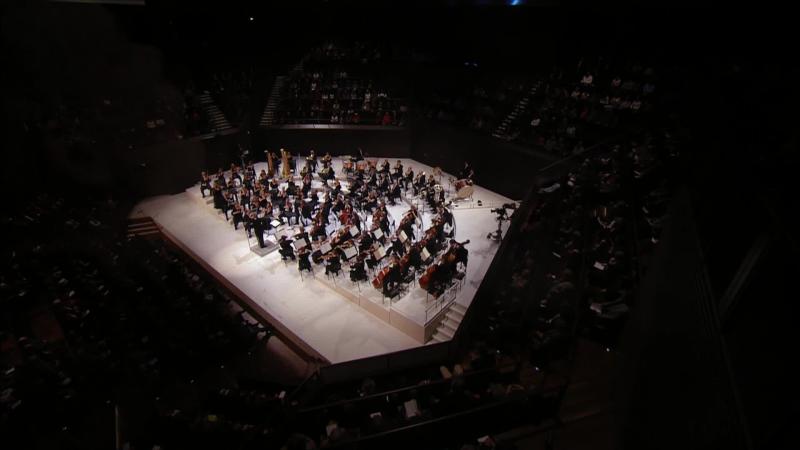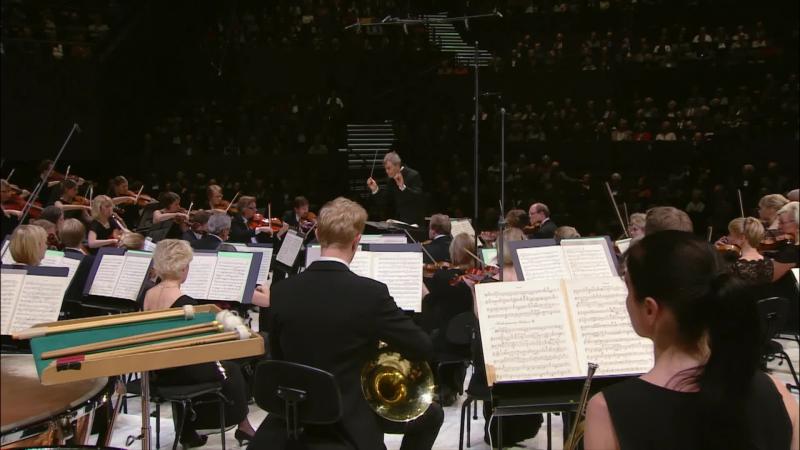

Sibelius Symphonies 1-7 (or Sibelius Complete Symphonies) box set. Hannu Lintu conducts the Finnish Radio Symphony Orchestra at the Helsinki Music Centre between 2012 and 2014. Also includes introductions discussing the musical themes for each symphony and extensive other documentary material about Sibelius the man. Directed for TV by Timo Anttila and Mika Paavilainen. Released 2015, disc has 5.1 dts-HD Master Audio sound. Grade: B+ for the entire box.
Wonk Bryan Balmer provides the following review:
Musically, the performances have been very satisfying to me. I appreciate the feeling of "event" and gravitas that permeates each performance—with conductor, orchestra, and audience all contributing to this feeling appropriately. There is a sense of reverence and respect for an important national figure. John Quinn of MusicWeb International concluded the performances to be "top class." In January 2016, Gramophone magazine gave the box it's "Editor's Choice" award for the month in the DVD/Blu-ray category.
From an audio perspective, the discs have 48kHz/24-bit sound files. The audio has been recorded at a realistic perspective, and is both clear and detailed. The video quality has a resolution that is on the soft side (i.e., a little fuzzy) when compared to the crystal clear and sharp images from the best NHK titles reviewed on this site.
To evaluate potential DVDitis and consistency among the 7 symphonies, I worked up statistics for 2 of them: Symphony No. 4 and Symphony No. 5. I chose these as they represent the first and last concert sessions. Although the statistics do show technical differences, I can report that that the concerts "feel" quite consistent.
Symphony No. 4 (recorded in November 2012)
Duration: 38 min, 25 sec
Total Cuts: 148
⦁ 20 = conductor-only
⦁ 13 = conductor over backs
⦁ 16 = solos
⦁ 53 = small sections
⦁ 18 = close-up images of instruments
⦁ 20 = large sections
⦁ 9 = most or full orchestra
This equates to approximately 80% of shots being suitable for lower-resolution viewing, and 20% for HDVD. The average cut length is over 15 seconds.
Symphony No. 5 (recorded in September 2014)
Duration: 33 min, 25 sec
Total Cuts: 223
⦁ 63 = conductor-only
⦁ 4 = conductor over backs
⦁ 7 = solos
⦁ 96 = small sections
⦁ 31 = large sections
⦁ 22 = most or full orchestra
This equates to approximately 76% of shots being suitable for lower-resolution viewing, and 24% for HDVD. The average cut length is 9 seconds.
My impression of these concerts having positive technical merits stems primarily from their relatively slow "pace" (longer average cut length). Also, the camera work is interesting. In particular, the cameras often shoot from higher angles than one usually sees. Then instruments, bows, and musicians' backs do not so often mar the images by blocking the views of other nearby musicians.
I did notice some changes in style between 2012 and 2014. The 2012 imagery included many extreme close-ups and instrument-only shots (e.g. the valves of a French horn, a bow moving over the strings). I did not notice these in the 2014 concert. The 2012 videography also includes a couple of other features that could have become very annoying except that they only occurred rarely—the use of blurring to transition between images, and the use of image fading (such that 2 different images are visible concurrently). I counted 3 instances of each effect in the 2012 recording, with none in 2014. Panning is typically done slowly and tastefully, although it does periodically cause a blip in focus.
Time for some screenshots. The first shot is not a valuable whole-orchestra view because the camera is too far away and you can't see the musicians well. You might call this an ant-hill shot:
But next below is a wonderful whole-orchestra view. The resolution is a bit soft. But at this range and with this view, you can see where all the different instruments are located on the stage:
The next view below uses the same camera crane position as above, but the cameraman has zoomed in for a part-orchestra shot. (You can tell this is from a different symphony than the preceding shot—-the horns are in a different place on the stage.)
And in the next shot below we zoom in even closer. From this range the TV director can provide an image with all the members of each of the string sections or of several string sections playing together:
And here's a shot of many of the winds playing while the strings rest:
And here's a beautiful angle of smaller woodwind sections working together:
Here's a great shot of a double-bass section with 7 players:
Next are two more multi-section shots of brass and the tympani. Sibelius loved the tympani, but he did not use much other percussion in the symphonies:
At the beginning of this series of shots, we saw many beautiful views of the strings from the camera crane on the left of the stage. It seems the camera crane on the right of the stage was further back and used for extreme long-range shots of the auditorium surrounding the stage. So how do you record the violins on the left of the stage? One way is to use a center camera, which in this hall has to be set up on the floor at a lower elevation. The image below of part of the violins looks almost like art photography:
And here's a nice near-shot. The only problem is we see the blond girl with the black hair-ribbon many, many times. True, she's gorgeous, but so are all the other women violin players. I think this just happened to be the easiest shot to get from one of the cameras:
And, of course, we have many great solo shots in the Sibelius box. The clarinetist here is playing the famous solo that opens Symphony No. 1:
Let's go back to the problem of showing the violins in Helsinki. The favored solution was to use a camera on the right side of the stage to get the next angle below. Is this a nice whole-section view, or is it a despised conductor-over-backs shot? In the still photo below, Lintu seems to be safely off to the side. But the human brain is hard-wired by evolution to urgently pay attention to any motion in the peripheral vision. So with the highly energetic Lintu in action, the view below is ambiguous. Whether it's good or bad depends on the context. If the camera continues to focus on the violins faithfully to the end of the clip, it's good. But most of the time the camera seems to eventually seek out Lintu like the compass pointing north, and then you have a conductor-over-backs shot:
Our last view below is a true, 100% conductor-over-backs shot. It's a bad shot of the far-away conductor and an insult to the musicians:
Now to a grade. In a special article on this website, the following rule-of-thumb statement is made: A good HDVD should have a slow pace with more than 10 seconds per video clip on average (longer the better). 20 to 40% (higher is better) of the clips should be large-scale "supershots" (whole-orchestra, part-orchestra, multiple-section, and large-section shots). Conductor shots should be less than 20% of the clips in the video. Following this, Symphony No. 4 would be an HDVD, but just barely. Symphony No. 5 would have a distinct case of DVDitis.
We ran the numbers on Symphony No. 1, which got a clean bill of health. But he also found that Symphony No. 2 has DVDitis with a too-brisk pace and too many conductor shots. This leads Hank and me to the conclusion that the TV directors in this series of films tried to make hybrid video that would please customers watching this in Blu-ray without ruining it for the DVD customers.
Judging the box as a whole, we deduct one grade for mild DVDitis and soft resolution. This yields a B+ grade for the box, which is a good grade on this website. The performances are very fine, and this box set should be expected to have broad appeal.













